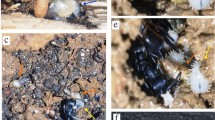Summary
The species combinations of myrmecophytic plants were compared in three different, neighboring local central Amazon forest sites. The proportional contribution of myrmecophytes in each setting varied significantly, withMaieta guainensis being the most abundant in each locality. This pattern resulted in low site similarity values. Other recorded species wereHirtella physophora, Tachigalia myrmecophila, Duroia sp.,Tococa sp., andCordia nodosa. Little variability was found with respect to associated ants that inhabited the myrmecophytes, and mutual entropies indicated a high degree of mutualistic interactions. However, for the majority of myrmecophytes, no differences in herbivore damage levels could be attributed to the presence of ants, with onlyM. guianensis andT. myrmecophila demonstrating significantly lower damages when inhabited by ants. Their respective ant associates,Pheidole minitula andPseudomyrmex concolor, were thus the only plant-ants with a demonstrable ability to reduce the levels of herbivory in their host plant.
Similar content being viewed by others
References
Bailey, I. W., 1923. Notes on neotropical ant plants. II.Tachigalia paniculata Aubl.Bot. Gazetter 75:27–41.
Beattie, A. J., 1985.The Evolutionary Ecology of Ant-Plant Interactions. Cambridge University Press, Cambridge.
Belt, T., 1874.The Naturalist in Nicaragua. John Murray: London.
Benson, W. W., 1985. Amazon ant plants. In:Amazonia (G. T. Prance and T. E. Lovejoy eds.), Pergamon Press: Oxford, pp. 239–266.
Bequaert, J., 1922. Ants in their diverse relations to the plant world.Bull. Am. Mus. Nat. Hist. 45:333–621.
Brillouin, L., 1962.Science and information theory. 2nd ed. Academic Press, New York.
Davidson, D. W., R. B. Foster, R. R. Snelling and P. W. Lozada, 1990. Variable composition of some tropical ant-plant symbioses. In:Herbivory: tropical and temperate perspectives. (P. W. Prince ed.), John Wiley & Sons: New York, pp. 145–162.
Couret, P., 1966. Observaciones sobre las mirmecofitas venezolanas.Mem. Soc. Cien. Nat. La Salle 26:5–40.
Davidson, D. W., R. R. Snelling and J. T. Longino, 1989. Competition among ants for myrmecophytes and the significance of plant trichomes.Biotropica 21:64–73.
Fonseca, C. R. S. D. da, 1991. Interação entreTachigalia myrmecophila Ducke (Caesalpinaceae) e formigas associadas. M. S. Thesis, Universidade de Campinas, Campinas, SP, Brazil.
Holdridge, L. R., 1967.Life Zone Ecology. Tropical Sciences Center: San José, Costa Rica.
Hölldobler, B. and E. O. Wilson, 1990.The Ants. Belknap Press of Harvard University Press: Cambridge.
Horn, H. S., 1966. Measurement of “overlap” in comparative ecological studies.Am. Nat. 100:419–424.
Huxley, C. R., 1986. Evolution of benevolent ant-plant relationships. In:Insects and the plant surface. (B. E. Juniper and T. R. E. Southwood eds.), Edward Arnold: London, pp. 257–294.
Kempf, W. W., 1972. Catálogo abreviado das formigas da região neotropical (Hymenoptera: Formicidae).Studia Ent. 15:3–344.
Kleinfeld, S. E., 1978. Ant-gardens: the interaction ofCodonanthe crassifolia (Gesneriaceae) andCrematogaster longispina (Formicidae).Ecology 59:449–456.
Kullback, S., M. Kupperman and H. H. Ku, 1962. Test for contigency tables and Markov chains.Technometrics 4:573–608.
Longino, J. T., 1989. Geographic variation and community structure in an ant-plant mutualism:Azteca andCecropia in Costa Rica.Biotropica 21:126–132.
Nimer, E., 1979.Climatologia do Brasil. SUPREN and IBGE, Rio de Janeiro, 421 p.
Orlóci, L. and N. C. Kenkel, 1985.Introduction to data analysis, with examples from population and community ecology. International Co-operative Publishing House: Burtonsville, MD.
Pielou, E. C., 1966. The measurement of diversity in different types of biological collections.J. Theor. Biol. 13:131–144.
Pires, J. M. and G. T. Prance, 1985. The vegetation types of the Brazilian Amazon. In:Amazonia. (G. T. Prance and T. E. Lovejoy eds.), Pergamon Press: Oxford, pp. 405–420.
Rajski, C., 1961. Entropy and metric spaces. In:Information theory (C. Cherry ed.), Butterworths: London, pp. 41–45.
Schmenske, D. W., 1983. Limits to specialization and coevolution in plant-ant mutualism. In:Coevolution. (M. H. Nitecki ed.), University of Chicago Press: Chicago, pp. 67–109.
Schnell, R., 1966. Contribution à l'étude des genres guyanoamazoniensTococa Aubl. etMaieta Aubl. et leurs poches foliaires.Adansonia 6:525–532.
Simberloff, D., 1979. Rarefaction as a distribution-free method of expressing and estimating diversity. In:Ecological diversity in theory and practice (J. P. Grassle, G. P. Patil, W. K. Smith and C. Taillie eds.), International Co-operative Publishing House: Burtonsville, MD.
Sombroek, W. G., 1984. Soils of the Amazon region. In:The Amazon: Limnology and Landscape Ecology of the Mighty Tropical River ant its Basin. (H. Sioli ed.), W. Junk: Dordrecht, pp. 521–535.
Vasconcelos, H. L., 1990. Mutualism betweenMaieta guianensis Aubl., a myrmecophytic melastome, and one of its ant inhabitants: ant protection against insect herbivores.Oecologia 87:295–298.
Wheeler, W. M., 1942. Studies of neotropical ant-plants and their ants.Bull. Mus. Comp. Zool. 90:3–262.
Wheeler, W. M. and J. C. Bequaert, 1929. Amazonian myrmecophytes and their ants.Zool. Anz. 82:10–39.
Author information
Authors and Affiliations
Rights and permissions
About this article
Cite this article
Fowler, H.G. Herbivory and assemblage structure of myrmecophytous understory plants and their associated ants in the central Amazon. Ins. Soc 40, 137–145 (1993). https://doi.org/10.1007/BF01240702
Received:
Revised:
Accepted:
Issue Date:
DOI: https://doi.org/10.1007/BF01240702




